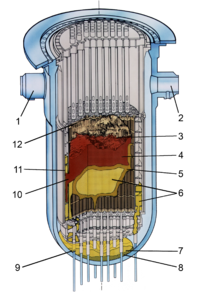
Photo from wikipedia
The surface morphology characteristics of postenrichment deconversion products in the nuclear fuel cycle are important for producing nuclear fuel pellets. They also provide the first opportunity for a microstructural signature… Click to show full abstract
The surface morphology characteristics of postenrichment deconversion products in the nuclear fuel cycle are important for producing nuclear fuel pellets. They also provide the first opportunity for a microstructural signature after conversion to gaseous uranium hexafluoride (UF6). This work synthesizes uranium oxides from uranyl fluoride (UO2F2) starting solutions by the wet ammonium diuranate route and a modification of the dry route. Products are reduced under a nitrogen/hydrogen atmosphere, with and without water vapor in the reducing environment. The crystal structures of the starting materials and resulting uranium oxides are characterized by powder X-ray diffraction. Scanning electron microscopy (SEM) and focused ion beam SEM with energy-dispersive X-ray spectroscopy (EDX) are used to investigate microstructural properties and quantify fluorine impurity concentrations. Heterogeneous distributions of fluorine with unique morphology characteristics were identified by backscatter electron imaging and EDX; these regions had elevated concentrations of fluorine impurities relating to the incomplete reduction of UO2F2 to UO2 and may provide a novel nuclear forensics morphology signature for nuclear fuel and U metal precursors.
Journal Title: ACS Omega
Year Published: 2023
Link to full text (if available)
Share on Social Media: Sign Up to like & get
recommendations!